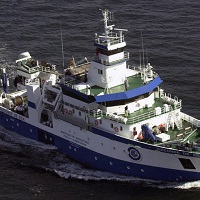Keyword
Vizconde de Eza
138 record(s)
Type of resources
Categories
Topics
INSPIRE themes
Keywords
Contact for the resource
Provided by
Years
Formats
Status
-

La creciente necesidad de informacion que requiere la evaluacion y gestion actuales de las especies explotadas, especialmente en el caso de la merluza, pero tambien en otros como los gallos, rapes o la cigala, hacen necesario obtener informacion independiente de las pesquerias sobre la situacion de estas poblaciones. Para lo cual se determino la realizacion de los siguientes objetivos:\nEstimacion de indices de abundancia estratificados por edad de merluza, rapes y gallos en las divisiones VIIbk.\nEstimacion de indices de abundancia estratificados de otras especies comerciales como la cigala, el mendo, las rayas o la brotola de fango.\nEstimacion de la fuerza de los reclutamientos y localizacion de las agregaciones de juveniles de merluza, rapes y gallos.\nDescripcion de los patrones de distribucion espacial de las especies demersales y bentonicas en el banco de Porcupine.\nObtencion de muestras de especies comerciales para estudios de niveles de contaminacion por arsenico y metales pesados.\nRecogida de muestras de especies para el estudio de la biologia de las principales especies comerciales en el area (otolitos, ilicios y otros).\nEstudio de la hidrografia (temperatura, salinidad y densidad de la columna de agua) del banco de Porcupine.\nMarcado de rapes para el estudio de sus migraciones y crecimiento.\nRecogida de ejemplares de jurel para estudios de genetica.
-

The surveys on NAFO Regulatory Area of Div. 3L (Flemish Pass) were initiated by Spain in 2003. The surveys were carried out by the R/V 'Vizconde de Eza' following the same procedures and using the same bottom trawl net type Campelen.The main objectives of this survey time series are: a) to obtain abundance indices of the main exploited species, b) to study the structure and distribution of these demersal species in the area.
-

The surveys on NAFO Regulatory Area of Div. 3L (Flemish Pass) were initiated by Spain in 2003. The surveys were carried out by the R/V Vizconde de Eza following the same procedures and using the same bottom trawl net type Campelen.The main objectives of this survey time series are: a) to obtain abundance indices of the main exploited species b) to study the structure and distribution of these demersal species in the area.
-

Abundance indices, distribution patterns and faunal assemblages of demersal species in the Porcupine bank, together with the possible driving factors of their distribution. This survey belongs to the research project: ?Evaluacion de Recursos Demersales por Metodos Directos en el Area ICES?. This Project is partly funded by the DCR of the EU and the Education and Science Spanish Ministery.The main objectives of the above mentioned project related with this survey time series are: a) to obtain abundance indices of the main exploited species in the Porcupine bank; b) to estimate the strength of yearly recruitments of these species and their distribution in the bank. c) to study the structure and distribution o the demersal and benthic communities in the area.
-

Study of the impact of the fishing fleet on vulnerable ecosystems in the area of the Hatton Bank.
-

- Reconocimiento sistematicode las zonas de estudio con recubrimiento al 100%, con ecosonda multihaz\n- Realizacion de perfiles sismicos de alta resolucion con el sistema de sonda parametrica TOPAS\n- Toma de muestras de roca y sedimentos\n- Toma de datos sistematicos de: Perfiles de velocidad del sonido en el agua y estacion meteorologica
-

Investigation of the sea floor by indirect and direct methods.
-

- Informacion en tiempo real de las estructuras de temperatura y salinidad de las capas superiores e intermedias de los oceanos.\n- Variabilidad de masas de aguas y calculos de transportes.Gyroscope
-

Study of the impact of the fishing fleet on vulnerable ecosystems in the area of the Hatton Bank.
-

Estimar la abundancia de las poblaciones de peces demersales Analizar la estructura y diversos parametros biologicos de las especies mas importantes.
 Catálogo de datos del IEO
Catálogo de datos del IEO